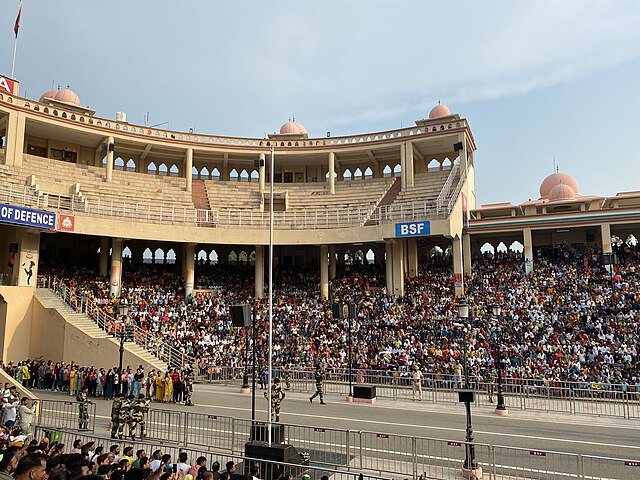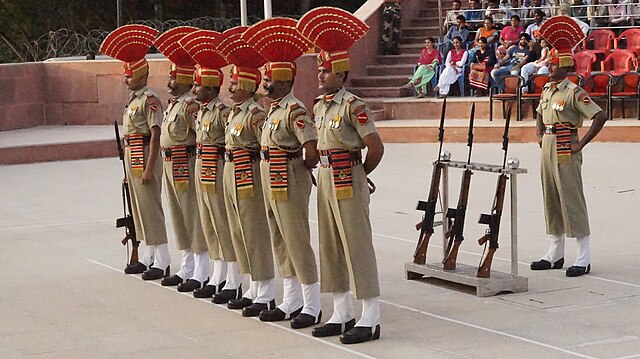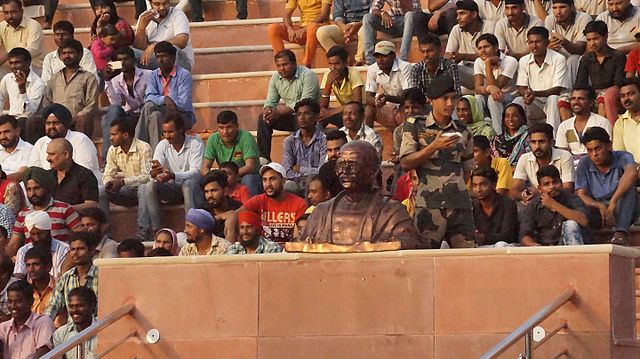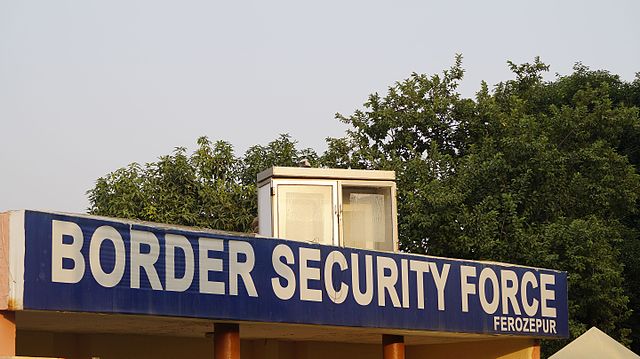Have you ever wondered what it feels like to stand at one of the world’s most emotionally charged borders? The Wagah Attari Border between India and Pakistan isn’t just a line on a map – it’s a living, breathing symbol of history, patriotism, and human drama that unfolds every single day.
Located just 32 kilometers from Amritsar in Punjab, this border crossing has become one of India’s most visited tourist attractions. But what makes thousands of people flock here daily? Is it the spectacular military ceremony, the patriotic fervor, or something deeper that touches the soul of every visitor?
What is the Wagah Attari Border?
The Wagah Attari Border represents more than just a geographical boundary between two nations. It’s the only road border crossing between India and Pakistan that’s open to civilians, making it a unique window into the complex relationship between these neighboring countries.
Historical Background and Significance
When the British partitioned the Indian subcontinent in 1947, they drew lines that would forever change millions of lives. The Wagah Attari Border stands as a testament to this monumental event in history. The border gets its name from two villages – Wagah on the Pakistani side and Attari on the Indian side.
This isn’t just any border crossing. It’s where families were separated, where dreams were shattered, and where new nations were born. Every day, as the sun sets, this border becomes a stage where the pain and pride of partition play out in a carefully choreographed ceremony that’s both moving and magnificent.
Geographic Location and Layout
Situated in the heart of Punjab, the border complex spans several acres with sophisticated infrastructure. The Indian side features a large amphitheater that can accommodate thousands of spectators, while security installations ensure the safety of all visitors. The actual border is marked by impressive gates on both sides, creating a dramatic backdrop for the daily ceremonies.
The Famous Wagah Border Ceremony

Picture this: thousands of people cheering, flags waving in the evening breeze, and soldiers in immaculate uniforms performing a dance that’s part military drill, part theatrical performance. This is the Wagah Border Ceremony – a daily spectacle that’s become legendary worldwide.
What Makes the Ceremony Special?
The ceremony isn’t just about military precision; it’s an emotional roller coaster that captures the essence of India-Pakistan relations. The soldiers from both sides engage in a carefully choreographed routine that’s simultaneously competitive and respectful. Their high kicks, aggressive stomping, and synchronized movements create an atmosphere that’s electric with patriotic energy.
What’s truly remarkable is how this ceremony manages to be both a display of military might and a celebration of shared heritage. The soldiers may represent different nations, but their movements mirror each other perfectly, almost as if they’re dancing to the same tune of history.
Timing and Schedule Details
Timing is everything when it comes to witnessing this spectacular show. The ceremony doesn’t follow a rigid schedule throughout the year – it adapts to the changing seasons and daylight hours.
Summer Timings
During the summer months (April to September), the ceremony typically begins at 5:15 PM and concludes by 6:00 PM. The gates usually open for visitors around 3:00 PM, giving you plenty of time to secure a good seat and soak in the pre-ceremony atmosphere.
Winter Timings
Winter brings earlier sunsets, so the ceremony shifts to accommodate the changing light. From October to March, the ceremony usually starts at 4:15 PM and wraps up by 5:00 PM. The gates open around 2:00 PM during these months.
Remember, these timings can change based on weather conditions, special occasions, or security considerations, so it’s always wise to check current schedules before planning your visit.
Planning Your Visit to Wagah Attari Border

Visiting the Wagah Border isn’t something you can do on a whim. It requires some planning, especially if you want to make the most of your experience. Think of it like planning to see a popular Broadway show – you need to arrive early, know what to expect, and come prepared.
How to Reach Wagah Border
Getting to the border is relatively straightforward, but you have several options depending on your starting point and budget.
From Amritsar
If you’re staying in Amritsar, you’re in luck. The border is just 32 kilometers away, which translates to about a 45-minute to 1-hour drive depending on traffic. You can hire a taxi, take a bus, or even join a tour group. Many hotels in Amritsar offer package deals that include transportation to and from the border.
Auto-rickshaws are another popular option, though they might not be the most comfortable for the journey. If you’re feeling adventurous and want to experience local transportation, buses run regularly from Amritsar’s main bus stand to Attari.
From Delhi and Other Cities
Traveling from Delhi or other major cities requires more planning. The most convenient option is to fly into Amritsar (Sri Guru Ram Dass Jee International Airport) and then proceed to the border. Alternatively, you can take a train to Amritsar Junction, which is well-connected to major Indian cities.
If you’re driving from Delhi, it’s about a 450-kilometer journey that takes approximately 6-7 hours. The route via NH44 is well-maintained and offers several rest stops along the way.
Entry Requirements and Security
Security at the Wagah Border is understandably tight. You’ll need to carry valid photo identification – an Aadhaar card, voter ID, passport, or driving license will suffice. Foreign nationals must present their passports.
The security screening process is similar to airport security. You’ll pass through metal detectors, and your bags will be X-rayed. It’s important to arrive well before the ceremony begins because the security process can take time, especially during peak tourist seasons.
What to Expect During Your Visit
Walking into the Wagah Border complex is like entering a carnival of patriotism. The atmosphere is electric, with vendors selling tricolor flags, patriotic songs playing in the background, and people from all walks of life united in their excitement for the upcoming ceremony.
The Complete Experience Timeline
Your Wagah Border experience begins long before the actual ceremony starts. Here’s what a typical visit looks like:
2:00-3:00 PM: Arrival and security check. This is when you’ll go through the screening process and enter the complex. Don’t rush this part – take time to observe the surroundings and get oriented.
3:00-4:00 PM: Finding seats and soaking in the atmosphere. The amphitheater fills up gradually, and you’ll want to secure a good spot. This is also when the pre-ceremony entertainment begins.
4:00-4:15 PM: Pre-ceremony activities intensify. Patriotic songs get louder, people start waving flags more enthusiastically, and the energy becomes palpable.
4:15-5:00 PM: The main ceremony unfolds. This is the moment you’ve been waiting for – the soldiers take center stage, and the real show begins.
5:00-5:30 PM: Post-ceremony activities and gradual exit. The formal ceremony ends, but the energy continues as people slowly make their way out, often singing patriotic songs.
Seating Arrangements and VIP Options
The seating at Wagah Border is designed to accommodate thousands of visitors, but not all seats are created equal. The amphitheater has different sections, and your experience can vary significantly depending on where you sit.
General seating is free and operates on a first-come, first-served basis. These seats offer a good view of the ceremony, but you’ll need to arrive early to secure the better spots. The atmosphere in the general section is incredibly energetic, with maximum crowd participation.
VIP seating is available for a nominal fee and offers several advantages. You get reserved seats with better views, separate entry gates that reduce waiting time, and sometimes refreshments. While the VIP section might be less raucous than general seating, it provides a more comfortable viewing experience.
Best Photography Spots and Tips
The Wagah Border offers incredible photographic opportunities, but capturing the perfect shot requires some strategy and knowledge of the rules.
Capturing the Perfect Moments
The golden hour lighting during the ceremony creates dramatic shadows and warm tones that are perfect for photography. The key is to focus on faces – the expressions of soldiers, the enthusiasm of spectators, and the emotion that fills the air.
Don’t just focus on the main ceremony. Some of the best shots come from candid moments: children waving flags, elderly visitors with tears in their eyes, or soldiers preparing backstage. The contrast between the formal military precision and the informal crowd enthusiasm creates compelling visual narratives.
Photography Guidelines and Restrictions
While photography is generally allowed, there are important restrictions to keep in mind. Professional cameras with large lenses might require special permissions. Video recording has specific guidelines, and commercial photography definitely needs prior approval.
The most important rule is to be respectful. This isn’t just a tourist attraction – it’s a place of deep emotional significance for many people. Avoid intrusive photography, especially of people who clearly don’t want to be photographed.
Cultural Impact and Symbolism

The Wagah Border ceremony has evolved into something much larger than its original purpose. It’s become a cultural phenomenon that speaks to the complex relationship between India and Pakistan.
Brotherhood Beyond Borders
What’s fascinating about the Wagah ceremony is how it manages to be both a display of national pride and a reminder of shared heritage. The soldiers on both sides often acknowledge each other with subtle gestures of respect. Spectators from both countries sometimes wave at each other across the border, creating moments of human connection that transcend political boundaries.
This ceremony has become a symbol of how conflict and cooperation can coexist. It’s aggressive yet respectful, competitive yet coordinated. In many ways, it mirrors the broader India-Pakistan relationship – complex, emotional, and deeply intertwined.
Tourism and Economic Impact
The border has become a significant economic driver for the region. Hotels, restaurants, souvenir shops, and transportation services in Amritsar have all benefited from the steady stream of tourists. Local artisans create and sell patriotic memorabilia, while tour operators have built entire packages around the border visit.
The ceremony has also put Amritsar on the global tourism map. International visitors often include Wagah in their India itineraries, contributing to the region’s growing reputation as a must-visit destination.
Practical Tips for First-Time Visitors
Visiting Wagah Border for the first time can be overwhelming. Here are some insider tips to help you make the most of your experience.
What to Bring and What to Avoid
Pack light but smart. Bring water bottles (you can buy them inside, but they’re more expensive), comfortable shoes (you’ll be doing some walking), and perhaps a small cushion if you’re planning to sit in general seating for extended periods.
Avoid bringing large bags, expensive jewelry, or anything that might complicate the security screening process. Power banks and electronic devices are generally allowed, but check current guidelines as these can change.
Most importantly, bring your patriotic spirit and an open mind. The ceremony is designed to evoke strong emotions, and the more you participate in the collective energy, the more meaningful your experience will be.
Best Time to Visit
While the ceremony happens daily (except during extreme weather or security situations), some times are better than others for visiting. Weekends tend to be more crowded, but they also have more energy and enthusiasm.
Weather-wise, the cooler months from October to March offer the most comfortable experience. The monsoon season (July-September) can be unpredictable, with ceremonies sometimes getting cancelled due to heavy rain.
Special occasions like Independence Day (August 15) or Republic Day (January 26) create extraordinary atmospheres, but they also draw massive crowds. If you’re looking for a more intimate experience, weekday visits during off-peak seasons might be preferable.
Nearby Attractions and Accommodations
Your trip to Wagah Border can easily be extended into a comprehensive Punjab experience. The region offers numerous attractions that complement your border visit.
Places to Visit Around Wagah
The Golden Temple in Amritsar is obviously the crown jewel of the region. This spiritual and architectural marvel is just 32 kilometers from the border and represents the heart of Sikh culture and heritage. The temple’s golden facade, sacred pond, and community kitchen (langar) create an experience that’s both spiritual and cultural.
Jallianwala Bagh, the site of the tragic 1919 massacre, offers important historical context for understanding the region’s complex past. The preserved bullet marks and memorial museum provide sobering reminders of the struggle for independence.
For those interested in military history, the Khalsa Heritage Museum and the Partition Museum offer detailed insights into the events that shaped modern India and Pakistan.
Where to Stay
Amritsar offers accommodation options for every budget and preference. Luxury hotels near the Golden Temple provide premium experiences with traditional Punjabi hospitality. Budget travelers can find comfortable guesthouses and hostels that offer basic amenities at affordable prices.
Many hotels offer special packages that include transportation to Wagah Border, meals, and sometimes guided tours of local attractions. These packages can be convenient and cost-e
 ffective, especially for first-time visitors.
ffective, especially for first-time visitors.
The Political and Historical Context
Understanding the Wagah Border requires appreciating the historical forces that created it. This isn’t just a tourist attraction – it’s a living piece of history that continues to evolve.
Partition of 1947 and Its Legacy
The partition of British India in 1947 was one of the largest mass migrations in human history. Millions of people crossed the newly created borders, often leaving behind everything they had known. The Wagah-Attari border was one of the main crossing points during this traumatic period.
The ceremonies that take place today are, in many ways, a continuation of the emotions and tensions that began during partition. The display of military might, the patriotic fervor, and the careful choreography all reflect the complex relationship between two nations that share so much history yet remain divided.
Modern India-Pakistan Relations
The Wagah Border ceremony serves as a barometer for India-Pakistan relations. During periods of tension, the ceremony might be more aggressive or even temporarily suspended. During better times, there might be subtle gestures of friendship and cooperation.
This border crossing also facilitates important people-to-people connections. Family members separated by partition sometimes meet here, and cultural exchanges occasionally take place. Trade, though limited, also passes through this crossing, making it an important economic link between the two countries.
Conclusion
The Wagah Attari Border is more than just a tourist destination – it’s a place where history comes alive, where emotions run deep, and where the complex relationship between India and Pakistan plays out daily. Whether you’re drawn by curiosity, patriotism, or simply the desire to witness something unique, the border ceremony offers an experience that’s both entertaining and deeply moving.
From the moment you enter the complex to the final notes of the national anthem, every aspect of the Wagah Border experience is designed to evoke strong emotions and create lasting memories. It’s a place where the personal becomes political, where individual stories merge with national narratives, and where the past continues to shape the present.
The ceremony itself might last only 45 minutes, but its impact often lasts a lifetime. Visitors frequently describe feeling a profound sense of connection – to their country, to history, and to the shared humanity that exists even across the most heavily guarded borders in the world.
Whether you’re an Indian feeling pride in your nation’s military prowess, a Pakistani watching from the other side with equal fervor, or an international visitor trying to understand the complexities of South Asian geopolitics, the Wagah Border offers insights that no textbook or documentary can provide.
Plan your visit, prepare for an emotional journey, and get ready to witness one of the world’s most unique daily spectacles. The Wagah Attari Border isn’t just a place you visit – it’s an experience that visits you long after you’ve returned home.
Frequently Asked Questions (FAQs)
1. What is the best time of day to visit Wagah Border?
The ceremony takes place in the evening, with timings varying by season. Summer ceremonies (April-September) typically start at 5:15 PM, while winter ceremonies (October-March) begin at 4:15 PM. Arrive at least 2-3 hours early to secure good seating and go through security checks comfortably.
2. Do I need special permissions or documents to visit Wagah Border?
You need valid photo identification such as Aadhaar card, voter ID, passport, or driving license. Foreign nationals must carry their passports. No special permissions are required for general visits, but commercial photography or large groups might need prior approval.
3. How much does it cost to visit Wagah Border?
Entry to the ceremony is free for general seating. VIP seating is available for a nominal fee (usually around ₹10-20). Transportation, food, and souvenirs are additional costs. Most expenses come from travel to reach the border rather than the ceremony itself.
4. Can I cross over to Pakistan through Wagah Border?
Yes, but only with proper visas and documentation. This is the only road border crossing between India and Pakistan open to civilians. However, casual tourists cannot simply walk across – you need valid Pakistani visas and must complete immigration procedures.
5. What should I do if the ceremony gets cancelled due to weather or security reasons?
Ceremonies can be cancelled during extreme weather conditions, security alerts, or special circumstances. Always check current status before traveling. If cancelled, you can explore nearby attractions like the Golden Temple, Jallianwala Bagh, or local markets in Amritsar. Many hotels and tour operators provide alternative arrangements or rescheduling options.
